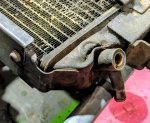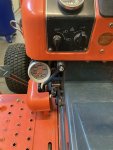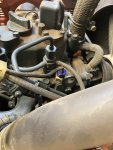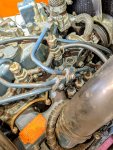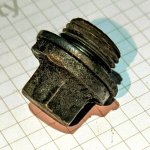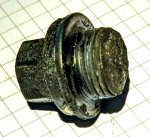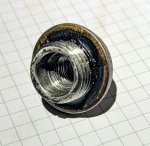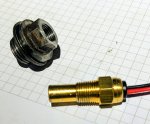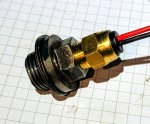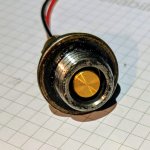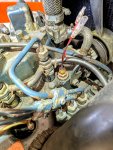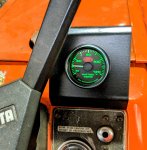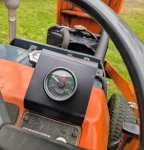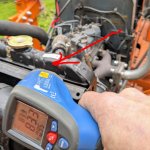Haha - lots to be learned here. Thanks.That hose is a burp hose.
It keeps the block from trapping a bubble in it and causing a hot spot.
It was eliminated on later models with a redesign of the thermostat housing.
B7200 running hot
- Thread starter Paul Allwood
- Start date
Before you toss your old radiator, you might consider taking it to a radiator shop to see what they can do for you. Mine got a pinhole leak in it a few years ago. I was surprised what an OEM rad cost back then. So I took it to my local shop and they repaired it for around $60. I haven't touched it since. They might have some tricks to flush yours free so you can reuse or keep as a spare....
North Idaho Wolfman
Moderator
Staff member
Lifetime Member
Equipment
L3450DT-GST, Woods FEL, B7100 HSD, FEL, 60" SB, 743 Bobcat with V2203, and more
That's all well and good if you can actually find a local radiator shop.Before you toss your old radiator, you might consider taking it to a radiator shop to see what they can do for you. Mine got a pinhole leak in it a few years ago. I was surprised what an OEM rad cost back then. So I took it to my local shop and they repaired it for around $60. I haven't touched it since. They might have some tricks to flush yours free so you can reuse or keep as a spare....
There is a local radiator repairer I went to once for something different - $2K to re-core. But that was quite a bit bigger - was a radiator out of an ex Australian army Unimog (my other tractor).Before you toss your old radiator, you might consider taking it to a radiator shop to see what they can do for you. Mine got a pinhole leak in it a few years ago. I was surprised what an OEM rad cost back then. So I took it to my local shop and they repaired it for around $60. I haven't touched it since. They might have some tricks to flush yours free so you can reuse or keep as a spare....
I will be keeping the old radiator, and nothing to lose by asking them for a price.
A new radiator arrived yesterday so I made a start on flushing and reassembly. A temperature sensor and gauge also arrived so I'll make an adaptor to fit it into the top radiator tube so I can monitor the temperature.
I flushed with tap water until the rusty water became clear.
The burp tube was almost completely blocked with rusty sludge. I initially couldn't get any flow through it with the hose but it cleaned out ok after I removed it. I have no way of knowing how long it's been like this or how many hours the previous owner ran it in this condition.
What could this do to the engine ?
Could it be the contribute to overheating and steam coming from the radiator overflow tube, or is that more likely a blocked radiator ?
I fitted a new thermostat to replace the old rusty one. The water pump looked like new so I re-fitted it. Hopefully tomorrow I'll get brackets transferred from the old radiator to the new and get the new one in.
What's everyone's thoughts about adding an overflow bottle ?
I flushed with tap water until the rusty water became clear.
The burp tube was almost completely blocked with rusty sludge. I initially couldn't get any flow through it with the hose but it cleaned out ok after I removed it. I have no way of knowing how long it's been like this or how many hours the previous owner ran it in this condition.
What could this do to the engine ?
Could it be the contribute to overheating and steam coming from the radiator overflow tube, or is that more likely a blocked radiator ?
I fitted a new thermostat to replace the old rusty one. The water pump looked like new so I re-fitted it. Hopefully tomorrow I'll get brackets transferred from the old radiator to the new and get the new one in.
What's everyone's thoughts about adding an overflow bottle ?
PS - I decided not to go ahead with a re-core. It looked like it had been dropped on the bottom fitting at some stage, didn't notice this initially.
Attachments
-
589.9 KB Views: 60
I don't think an overflow is needed. Adding that temp gauge will go a long way to help prevent major overheating. You'll learn its normal operating temperatures after a few uses. From there you just keep an eye on the temp gauge and check the system if it starts to creep up.A new radiator arrived yesterday so I made a start on flushing and reassembly. A temperature sensor and gauge also arrived so I'll make an adaptor to fit it into the top radiator tube so I can monitor the temperature.
I flushed with tap water until the rusty water became clear.
The burp tube was almost completely blocked with rusty sludge. I initially couldn't get any flow through it with the hose but it cleaned out ok after I removed it. I have no way of knowing how long it's been like this or how many hours the previous owner ran it in this condition.
What could this do to the engine ?
Could it be the contribute to overheating and steam coming from the radiator overflow tube, or is that more likely a blocked radiator ?
I fitted a new thermostat to replace the old rusty one. The water pump looked like new so I re-fitted it. Hopefully tomorrow I'll get brackets transferred from the old radiator to the new and get the new one in.
What's everyone's thoughts about adding an overflow bottle ?
ThanksI don't think an overflow is needed. Adding that temp gauge will go a long way to help prevent major overheating. You'll learn its normal operating temperatures after a few uses. From there you just keep an eye on the temp gauge and check the system if it starts to creep up.
Runs With Scissors
Well-known member
Equipment
L2501 TLB , Grappel, Brush Hog, Box Blade, Ballast box, Forks, Tiller, PH digger
I have only had one vehicle where the “overflow” bottle really 'kind of mattered', and that was on a Jetta. It would throw a “check engine” light if it got too low.
Other than that, I rarely pay attention to them.
I like the temp gauge idea though.
Other than that, I rarely pay attention to them.
I like the temp gauge idea though.
Thanks. The temp gauge wasn't my idea - it was suggested by N3BP in one of the comments above. I liked the idea too.I have only had one vehicle where the “overflow” bottle really 'kind of mattered', and that was on a Jetta. It would throw a “check engine” light if it got too low.
Other than that, I rarely pay attention to them.
I like the temp gauge idea though.
Last edited:
I'm curious to hear what your temp readings are, so please report those back. I installed the temp sensor in a port plug on top of the cylinder head. The gauge got mounted under the dash. It's not an ideal location due to poor visibility, plus I had to remove the cruse control lever. But I couldn't find a better spot where it isn't in the way of something.
Attachments
-
177.9 KB Views: 64
-
161.4 KB Views: 62
I like where you've mounted the sensor - thanks for the info. Think I'll try to do mine the same way instead of making a fitting for the top radiator hose. I'll let you know how this goes and what temps I get one I can give it a good run.I'm curious to hear what your temp readings are, so please report those back. I installed the temp sensor in a port plug on top of the cylinder head. The gauge got mounted under the dash. It's not an ideal location due to poor visibility, plus I had to remove the cruse control lever. But I couldn't find a better spot where it isn't in the way of something.
Don't have temp readings yet, but I got the sensor mounted in the same spot that you used alongside the first injector. I used the existing plug and drilled and tapped it to 1/8" NPT to match the sensor in the kit.I'm curious to hear what your temp readings are, so please report those back. I installed the temp sensor in a port plug on top of the cylinder head. The gauge got mounted under the dash. It's not an ideal location due to poor visibility, plus I had to remove the cruse control lever. But I couldn't find a better spot where it isn't in the way of something.
Thanks again - I would never have looked at this spot.
Attachments
-
729.9 KB Views: 47
-
247.2 KB Views: 39
-
153.9 KB Views: 46
-
276.8 KB Views: 46
-
298.1 KB Views: 44
-
524.4 KB Views: 37
-
302.7 KB Views: 45
-
406.4 KB Views: 45
-
676.5 KB Views: 40
I always seem to struggle with wiring, but managed to get the temperature gauge mounted and wires connected. And it seems to be working. Up to about 50 deg C after 5 minutes idling at 1500 rpm.
Have to head inside to watch the footy now so giving it a good run will have to wait
Have to head inside to watch the footy now so giving it a good run will have to wait
Attachments
-
517.1 KB Views: 49
Last edited:
Runs With Scissors
Well-known member
Equipment
L2501 TLB , Grappel, Brush Hog, Box Blade, Ballast box, Forks, Tiller, PH digger
Thats a nice looking gauge.I always seem to struggle with wiring, but managed to get the temperature gauge mounted and wires connected. And it seems to be working. Up to about 50 deg C after 5 minutes idling at 1500 rpm.
Have to head inside to watch the footy now so giving it a good run will have to wait
I like it too - $80 (Australian) on eBay for the whole sensor and gauge kit.Thats a nice looking gauge.
Glad to hear you got it installed and it's working.
I had to cut the grass today, so I thought I'd share my readings. It was 75 (24c) out today with 50% humidity. Here is what my gauge showed:
During mowing: 180 (82c)
Idle cool down after mowing (5 min idle) 170 (77c)
A minute or two after shutting it off (always the hottest reading 185 (85c). From there it slowly cools down.
I had to cut the grass today, so I thought I'd share my readings. It was 75 (24c) out today with 50% humidity. Here is what my gauge showed:
During mowing: 180 (82c)
Idle cool down after mowing (5 min idle) 170 (77c)
A minute or two after shutting it off (always the hottest reading 185 (85c). From there it slowly cools down.
Thanks againGlad to hear you got it installed and it's working.
I had to cut the grass today, so I thought I'd share my readings. It was 75 (24c) out today with 50% humidity. Here is what my gauge showed:
During mowing: 180 (82c)
Idle cool down after mowing (5 min idle) 170 (77c)
A minute or two after shutting it off (always the hottest reading 185 (85c). From there it slowly cools down.
No longer running hot 
10 days ago after mowing for about 20 minutes I had steam coming out of the radiator overflow.
After mowing for about 90 minutes today, it ran well with no steam. I got the following temps from my new gauge with the sensor mounted in the head next to the first injector:
- Mowing at 2500 rpm 60 deg C [140 F]
- Stopped for a couple of minutes at idle 65 deg C [149 F]
- Max temp about 10 minutes after stopping 73 deg C [163 F]
When the temp in my new gauge read 60 deg C [140 F] the temp in the front of the top radiator tank in line with the inlet read 83 deg C [181 F] using a non-contact IR thermometer
Looks like the new gauge/sensor/sensor location is reading about 23 deg C [41 F] lower than the radiator top tank temp.
This shouldn't bother me as it will still give an indication of something changing if the gauge temp changes significantly, and this was the original intention. But there's this little voice inside wanting it to read right, at least a bit righter.
10 days ago after mowing for about 20 minutes I had steam coming out of the radiator overflow.
After mowing for about 90 minutes today, it ran well with no steam. I got the following temps from my new gauge with the sensor mounted in the head next to the first injector:
- Mowing at 2500 rpm 60 deg C [140 F]
- Stopped for a couple of minutes at idle 65 deg C [149 F]
- Max temp about 10 minutes after stopping 73 deg C [163 F]
When the temp in my new gauge read 60 deg C [140 F] the temp in the front of the top radiator tank in line with the inlet read 83 deg C [181 F] using a non-contact IR thermometer
Looks like the new gauge/sensor/sensor location is reading about 23 deg C [41 F] lower than the radiator top tank temp.
This shouldn't bother me as it will still give an indication of something changing if the gauge temp changes significantly, and this was the original intention. But there's this little voice inside wanting it to read right, at least a bit righter.
Attachments
-
477.1 KB Views: 32
-
451 KB Views: 35
North Idaho Wolfman
Moderator
Staff member
Lifetime Member
Equipment
L3450DT-GST, Woods FEL, B7100 HSD, FEL, 60" SB, 743 Bobcat with V2203, and more
The radiator top of tank will always read higher as it's steam and not coolant.
It could also be that you don't have the senso far enough down into the head.
It could also be that you don't have the senso far enough down into the head.


